Email marketing and newsletters are often confused – after all, you use the same tools to send both. There is a huge difference between newsletters and email marketing though and sending email marketing as newsletters is one of the biggest mistakes and often a key reason
What are newsletters? The characteristics and goals of newsletters
I’m a bit of a newsletter junkie and over the years, I’ve subscribed to quite a few newsletters. Some of them I read regularly, some of them less so – but what all of them have in common is that they are essentially letters sent to *me* from the author on a (more or less) regular basis.
Hence, the newsletters are:
- Personal (think news + letters) – written in first person, addressing one person, written in an informal tone of voice, using personal language and sense of humor, describing personal experiences and news – as if the author was writing to a friend and sharing their latest news with them. Hence the name newsletter.
- Opinionated – the author is sharing her/his personal opinions with you on a topic they are experts on.
- Value-packed – the main reason why people read newsletters is that they provide so much value to them: either in advice, information, or psychological value of food-for-thought/ sharing the same experiences, struggles, etc.
- Relationship, NOT sales-oriented – a newsletter is focused on sharing value and building trust, not on sales. You won’t find a sales offer in your first newsletter from someone. OK, occasionally the newsletter author may share a deal they have with you – but this should be less than 20% of your communication. Yes, you can use your newsletters to sell sometimes – but think in terms of 80:20 – 80% value, 20% sales.
- Plain text – hey, let’s face it: if you write an email to a friend, you won’t spend an hour designing a fancy template. You will write in plain text, adding some emojis, or maybe a photo or two, or a GIF to illustrate something in the text – express emotions, etc.
- Links are part of the text – you may (and probably should) include some links to your e.g. blog so the reader can read more. But no flashy CTA buttons encouraging the readers to ‘shop now’ or do whatever.
- Short(-ish) – well, in fact – as long as they need to be. But in general – a newsletter is not an essay or a blog post. If you want to share more information – encourage your reader to read the relevant blog post by linking to it.
- Regular – your audience expects you to communicate with them regularly, aka – if you make a ‘promise’ you will send a new newsletter every Tuesday – stick to it. Even if you are to write some of your newsletters a few weeks in advance – that’s why you need a tool for sending newsletters.
Wanna learn how to write good newsletters? Check our earlier post here.
Examples of good newsletters – my favorite newsletter examples
Here are two newsletters from Sabrina Phillip and Mark Mason that I read fairly regularly:
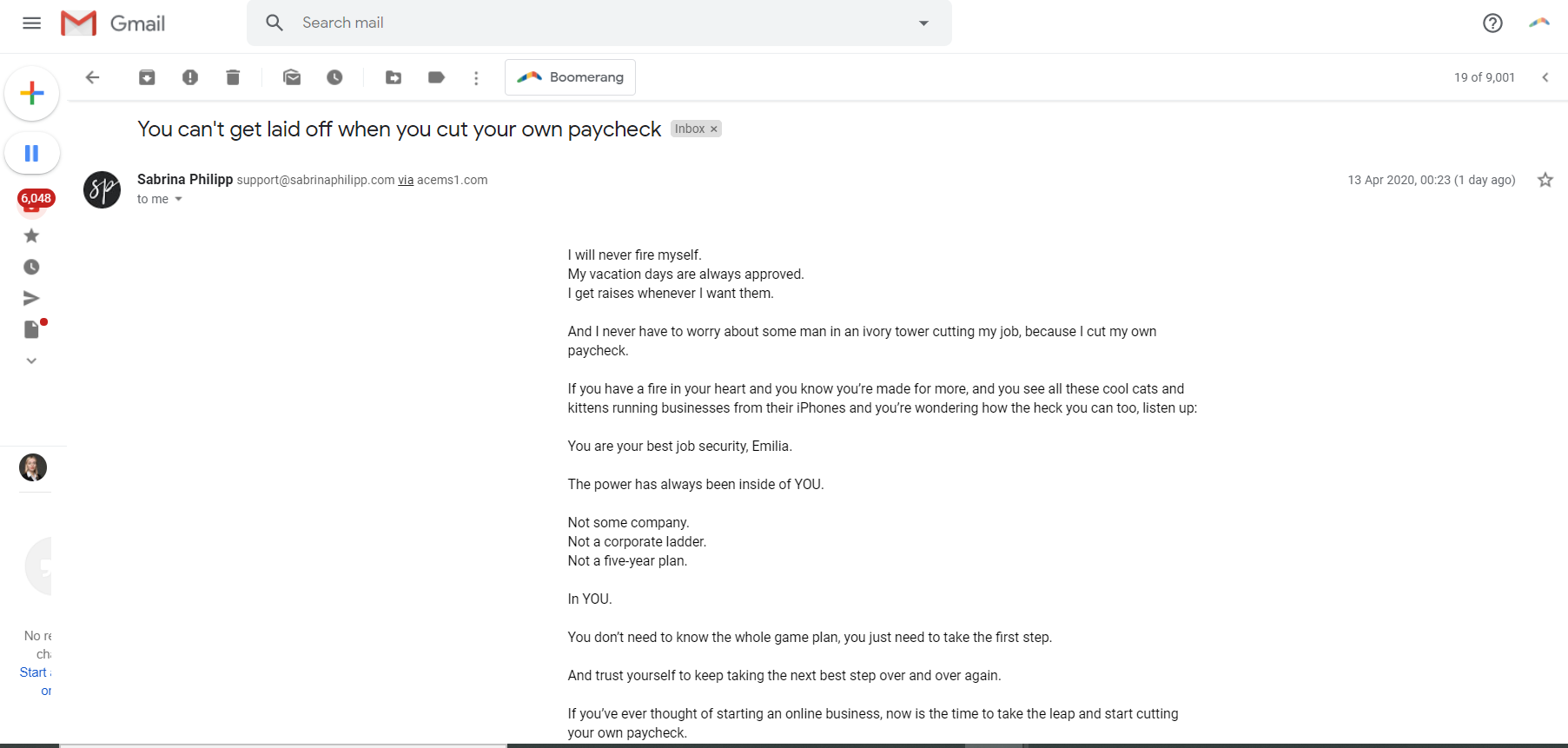

As you can see – it’s personal, and speaks to *me* directly and from first-hand experience. And so it Mark Mason’s newsletter – mark (pun unintended…) how it’s *all* about his personal opinions.
Not happy with the f*cks? Then move on – Mark Mason, the author of ‘The Subtle Art of Not Giving a F*ck’ is known for his strong language and is not going to compromise on his personal style to please anyone (and possibly reach a wider, but not the as engaged audience – which is not your goal when writing a newsletter, btw.)
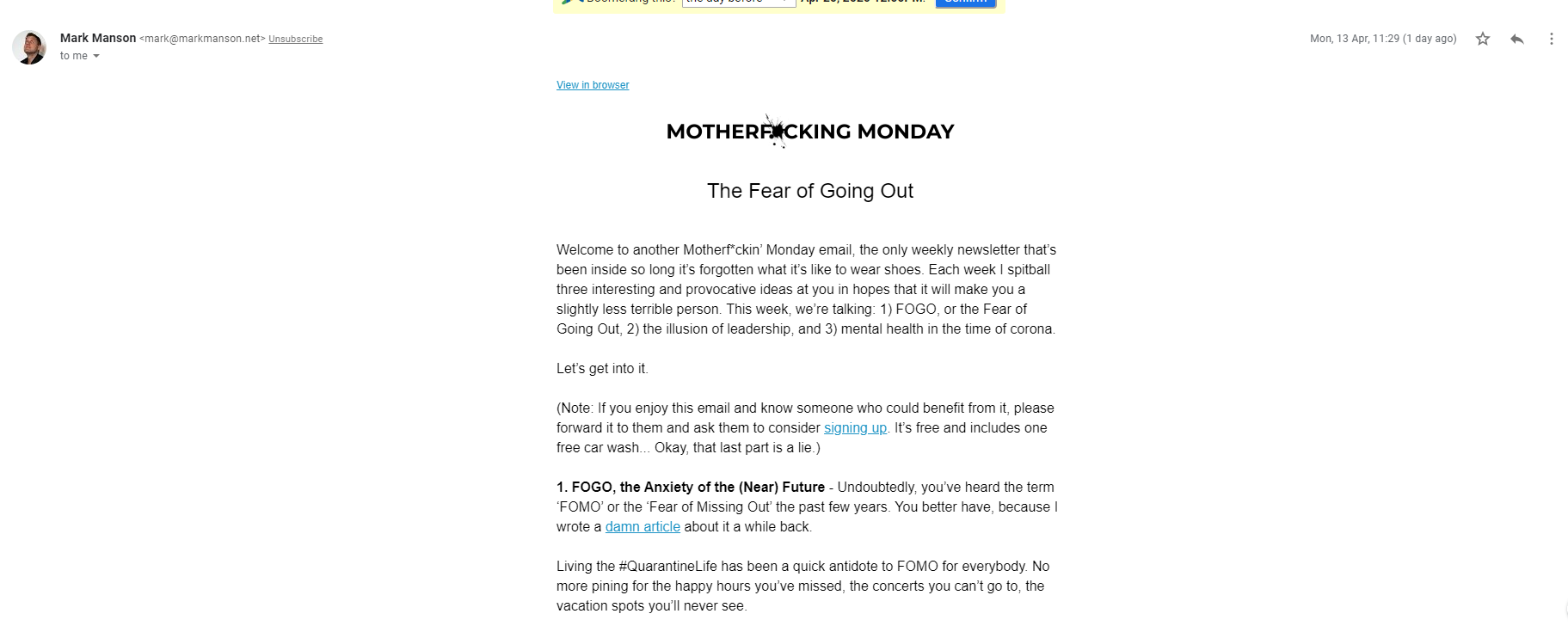

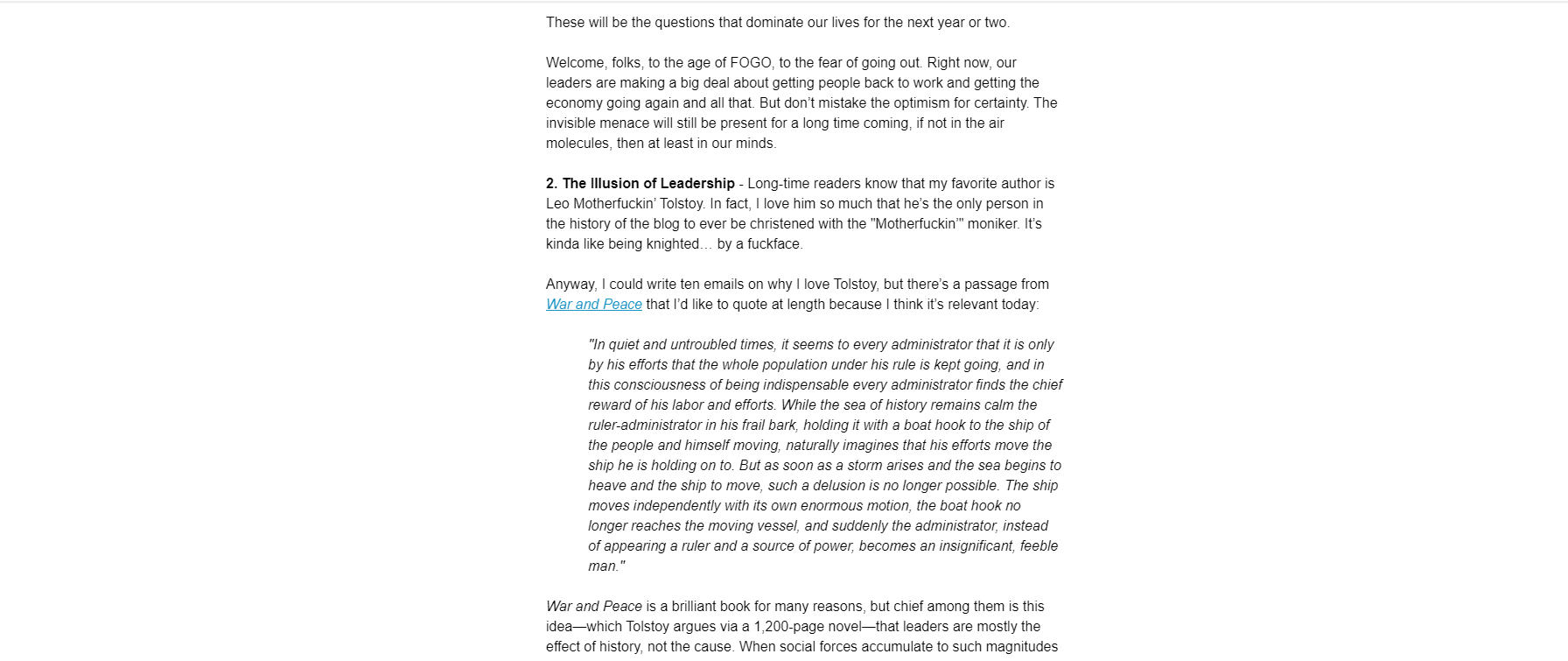
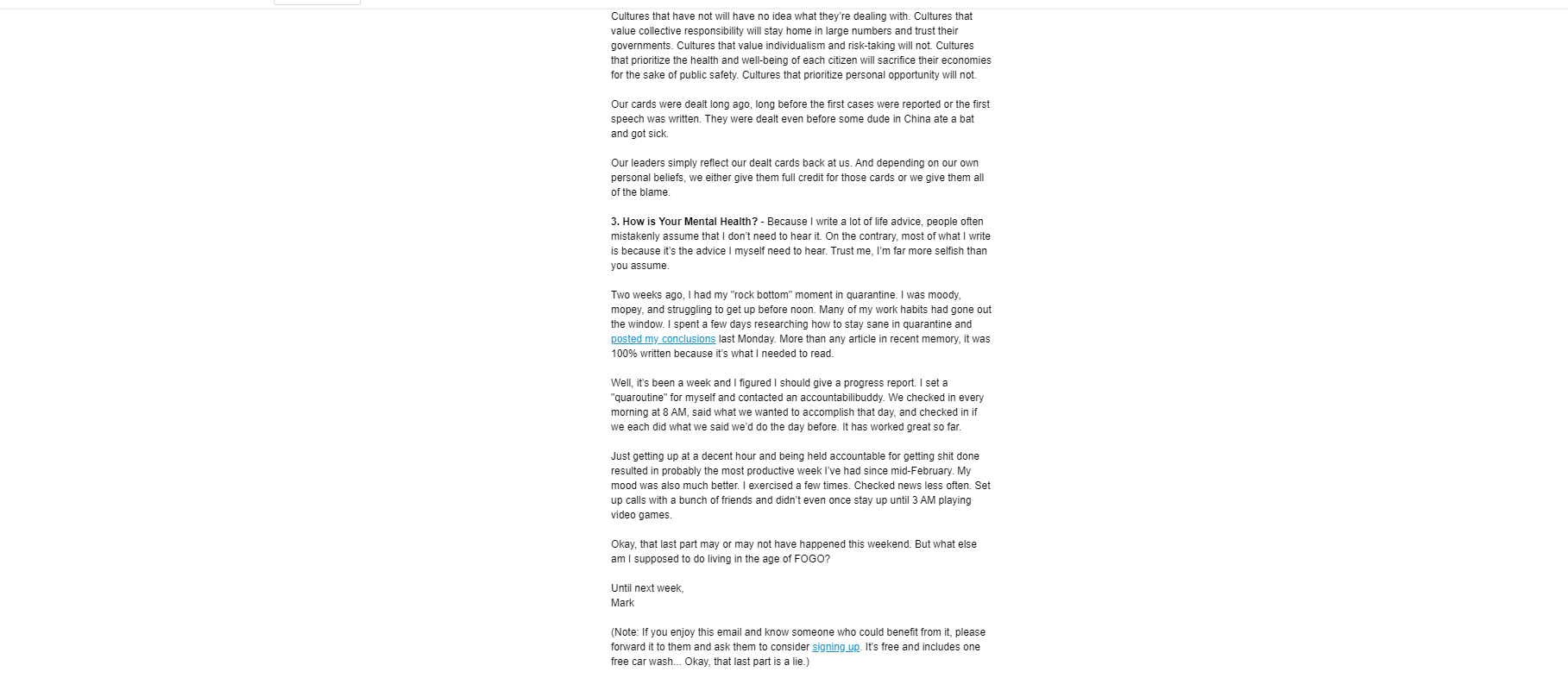
Why are most newsletters bad?
As I said earlier: a lot of people confuse newsletters with email marketing. Hence – what you get is more often than not an example of how *not* to write a newsletter:
- Boooring – you can really tell when someone is just going through the motions and has completely nothing to say…maybe the topic you are writing about it not important enough, or it doesn’t provide enough value to your audience – but the end effect is such that your newsletter is simply not a compelling read.
- Lacking opinions & personality – see above – if you want to be boring, don’t have an opinion. Don’t use strong language. Nobody will care about your newsletter and nobody will read it. Such newsletters lack passion, and personality, and are so ‘balanced’ and ‘nice’ that you can’t possibly care about them… If you want to please everybody – sell ice cream (as the late Steve Jobs used to say…)
- Not authentic – if your newsletter is based on second-hand experiences rather than your own – you can be sure it will sound fake and disingenuous.
- Violating the 80:20 rule AKA Salesy – the primary goal of your newsletter should be to provide value, not sell. If more than 20% of your total communication is about sales – you’re doing it wrong.
Why should you write newsletters?
OK, so if newsletters are more about personal communication than sales, then what is the purpose of them at all (if you run a business)?
- Newsletters allow you to establish yourself as an expert (build your personal brand)- and that really helps your business sell – even if you don’t sell via your newsletters at all! If people recognize you as the CEO of your business and see your expertise in your newsletters – they will be more likely to give their business to your company even if you don’t ask for a sale at all.
- You will have a more personal relationship with your audience – my favorite part of writing newsletters is when my subscribers actually reply to them. Your newsletter is like your personal newspaper and a reality show combined – you will polarize your audience, and make both rabid fans and enemies.
And that’s the point – that people feel like they know you personally from your newsletters. People don’t like buying from businesses – they like buying from people. If you have a larger company – you could get your different employees to run their own newsletters and thus build their personal brands too. - Your brand will be more human – as I mentioned earlier – it’s not B2B or B2C – it’s always Human-to-Human at the end of the day. The most successful brands are using employee advocacy these days – using real people (employees) and their real networks to connect with potential customers and ultimately sell. You can do it both on social media and via newsletters.
What to write in your newsletters?
- News – what is happening in your business and life right now – of course keep it relevant to the overall ‘expert theme’ of your newsletter – i.e. if you’re writing about Italian Food or Customer Retention Tactics in SaaS – don’t write about UX in the former and about pizza in the latter.
Have you recently been to a trade show or conference? Have you read something that inspired you? Have you created a new recipe? Have you traveled to an interesting place/ had a stimulating conversation/ met an interesting person? - Opinion/ commentary – comment on recent events related to the theme of your newsletter. For example, are you writing about SEO and marketing? You could e.g. comment on how the coronavirus pandemic affected SEM. Make sure to write your opinions, not just regurgitate the opinions of others.
- Valuable tips on “how-to-do something” – if you have hacked a particular method to do something that’s related to your newsletter theme – share it with your audience.
- Curated content – share the blogs, books, podcasts, YouTube videos, conferences, people, Tweets – anything related that inspires you. Group them by weekly themes.
What is email marketing? The characteristics and goals of email marketing
Unlike newsletters – the main goal of email marketing is to sell something.
Of course – you still need to provide value and show the benefits of your product/ service in a context that is relevant to your audience. But the primary reason for this is because you ultimately want to make them buy – not to reflect upon your opinions or connect with you.
So – e.g. if you are selling e.g. clothes – you may write about the latest fashion trends. But the primary reason is to make your readers want to buy the fashionable items you are selling.

Here are the features of email marketing emails:
- Impersonal style – mostly written on behalf of a brand, email marketing is written in an impersonal style, and often resembles an elaborate advertisement. You will not find opinions, personal experience, or otherwise personal content in email marketing (usually – there are some email marketing newsletters that combine the two successfully, as the one below).
- Sales-focused – the value-to-sales ratio this time is around 20:80 – you focus on presenting your offers
- Offers, Vouchers, and Discounts are welcome – a lot of your users are literally signing up for your newsletters for the sake of getting those discounts.
- Elaborate templates – unlike newsletters, email marketing emails are usually a lot more elaborate and visually pleasing – they are focusing on attracting the potential customer’s attention, especially in B2B – so the visuals play an important role in email marketing:
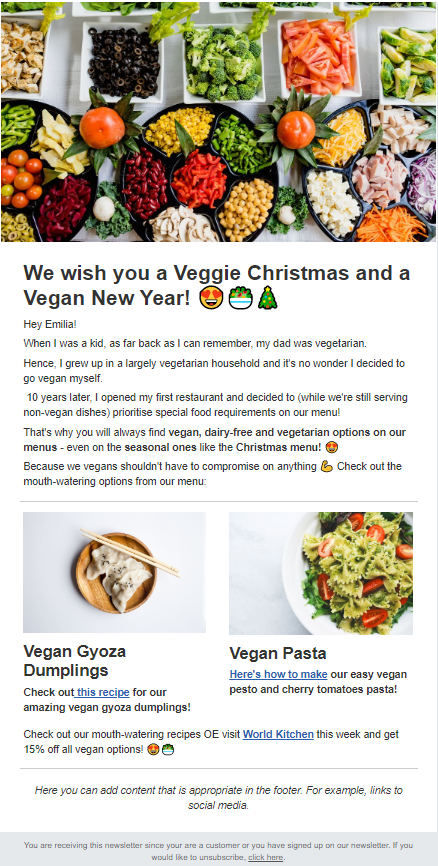
What are transactional emails? The characteristics and goals of transactional emails
The third type of email you can get from a business is the so-called ‘translational email’. Unlike newsletters and email marketing emails, transactional emails are sent (as the name suggests) as a part of a certain ‘transaction’ the recipient has entered, for instance:
- Welcome emails and email confirmation emails
- purchase confirmation email
- order delivery data email
- information about product updates and feature releases (in the case of software products)
- terms and conditions changes emails
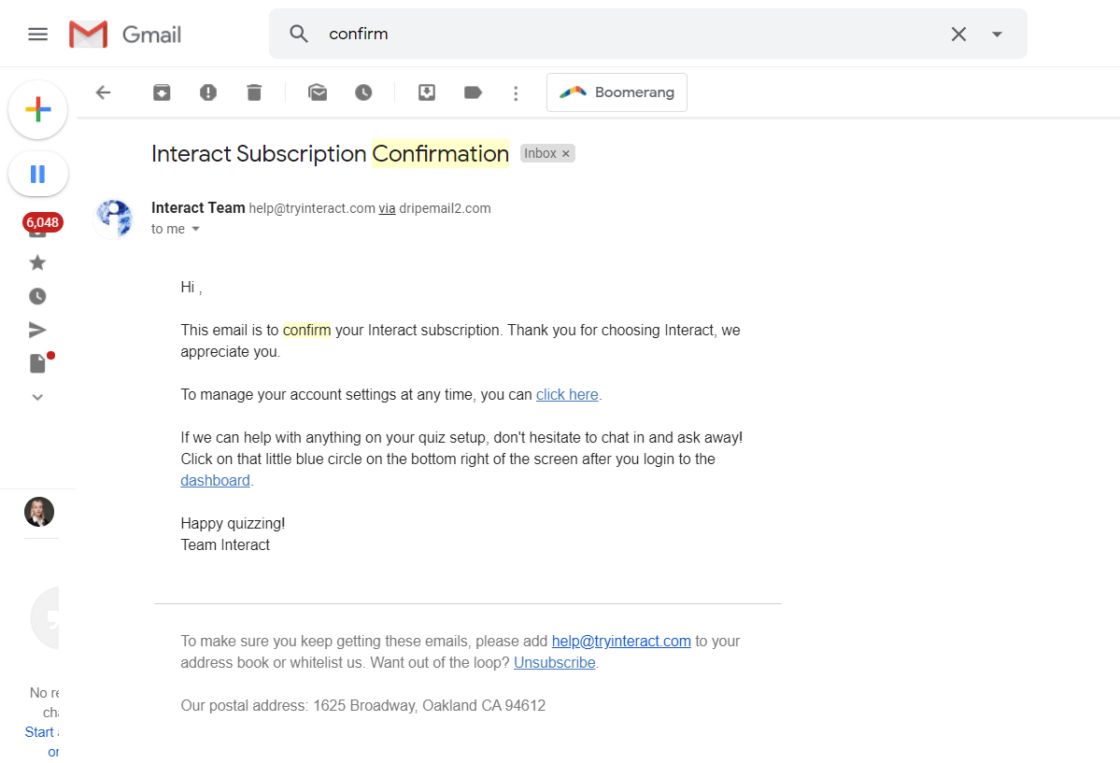
Unlike with newsletters and email marketing emails, you don’t have to ask your users for marketing permissions to send transactional emails – accepting your terms and conditions of service is enough.
Newsletter vs email marketing – Conclusion
To sum up, newsletters are different than email marketing emails, and transactional emails:
- Newsletters are mainly personal, and while they may sell through building personal brand and brand awareness, they are mainly designed to nurture relationships mid-funnel;
- Email marketing emails are more like sales brochures
- There are also ’email marketing newsletters’ which fall somewhere in between, of course – however if your audience expects a personal newsletter with tips and best practices – and you keep sending them offers – they will get frustrated and unsubscribe
- Transactional emails support the sales process and communicate important product updates to existing users.
Get started with email marketing
Create beautiful email newsletters for free with Get a Newsletter and reach your subscribers and customers in a heartbeat.
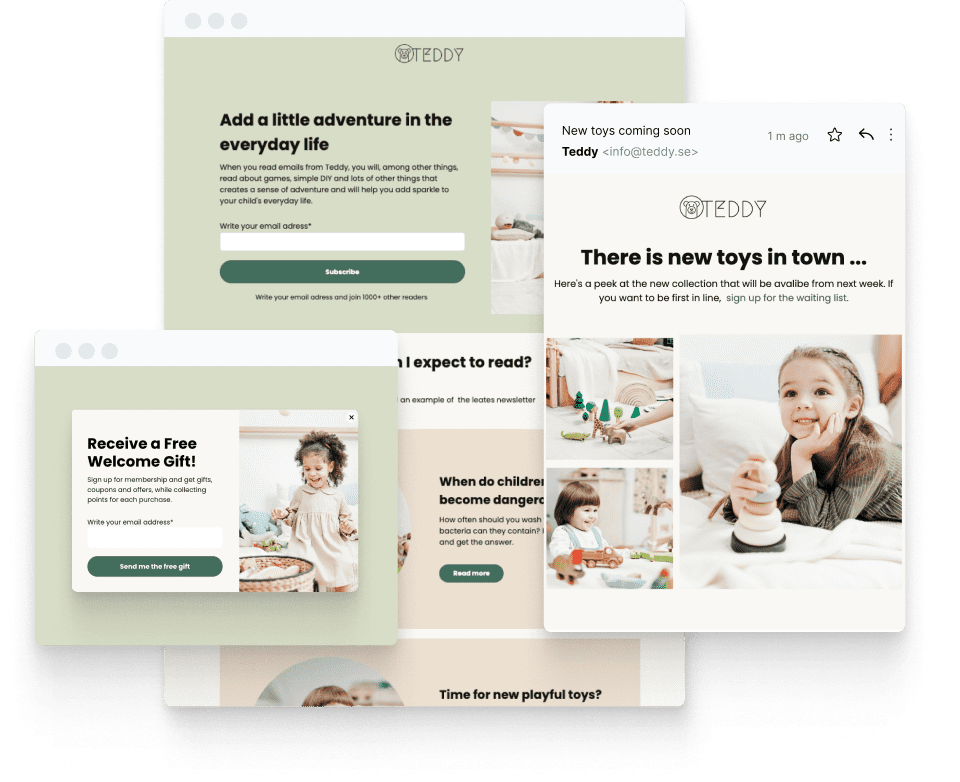
Leave a Reply